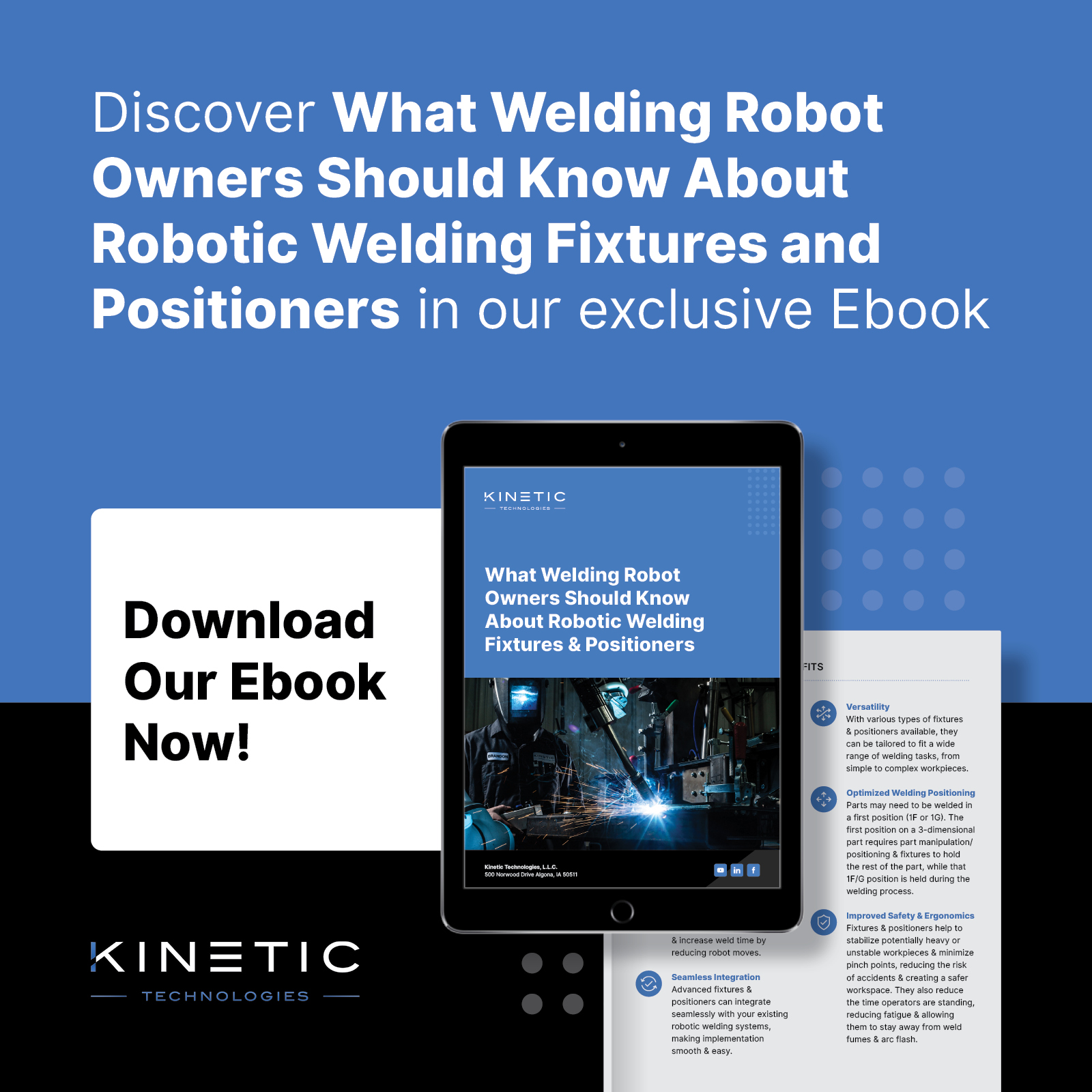If you’re doing robotic welding, a robotic welding fixture should be an essential part of your process. It ensures productivity and repeatability, making it easier for a robot to weld with less setup time.
Regardless of the complexity of the task, a good welding fixture guarantees that each part aligns with the next, which translates to fewer defects, less waste, and higher quality outcomes. This not only saves time and resources but also enhances the overall competitiveness of your manufacturing operations.
The purpose of this blog is to shed light on the cost implications of integrating a well-designed welding fixture into your manufacturing processes, particularly for companies that rely on robotic welding operations. We’ll talk about the costs, ROI, and benefits of investing in a high-quality fixture.
If you are struggling with the design and fabrication of your own fixtures, this article aims to provide a clear understanding of the benefits of finding a partner to help you design and fabricate your welding fixtures. By the end of this article, you will be equipped with the knowledge to make informed decisions that can enhance your operational efficiency, productivity, and competitiveness in the market.
In this article
• Impact of Welding Fixtures on Fabrication Productivity ›
• Criteria for a Good Welding Fixture ›
• Understanding the Cost of a Robotic Welding Fixture ›
• Benefits of Outsourcing Robotic Welding Fixtures ›
• Final Thoughts ›
• Invest in Your Future with Us ›
• FAQ ›
Impact of Welding Fixtures on Fabrication Productivity
A well-designed robotic welding fixture can impact your welding production in several ways.
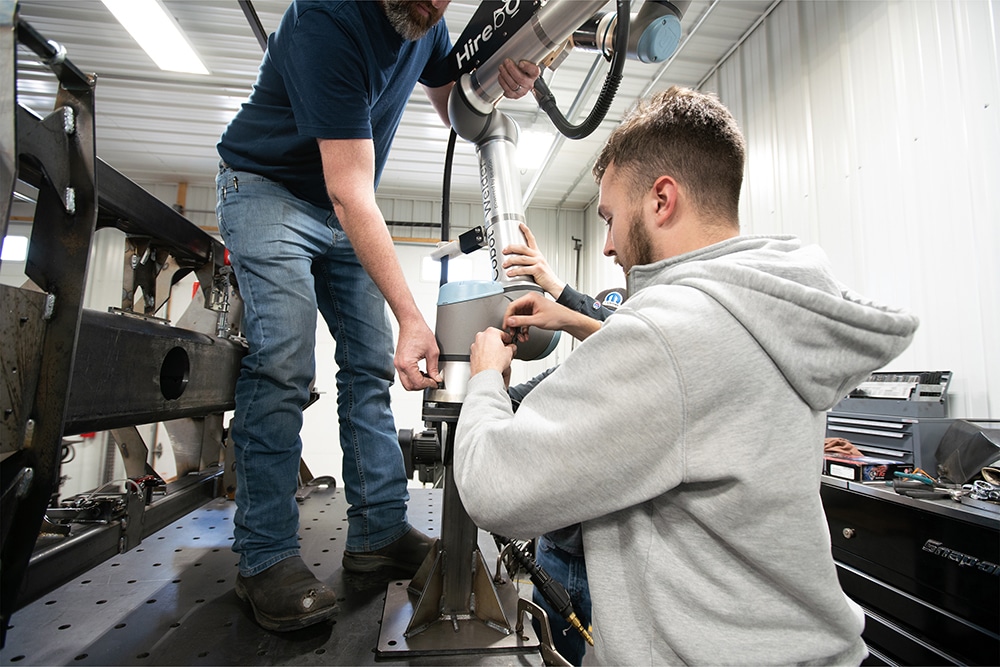
1. It reduces setup and changeover times. The exact fit and repeatability of a top-quality fixture eliminates the need for time-consuming part adjustments, allowing for faster switchover between different welding tasks.
2. It minimizes the rate of defective welds. By holding parts in the correct position, the fixture ensures precision in the welding process, reducing the occurrence of defects and the need for costly rework. As a result, the organization can process higher volumes of work within a given time frame.
3. A well-engineered fixture ensures high-quality work output from your robotic welding cell. This is especially critical as robots can’t easily adapt to unplanned part variations.
Real Life Example:
For one of our customers, the addition of a fixture system had a significant impact on productivity. Initially, certain areas of the part were challenging to access with the Cobot Welder due to its size. Despite this limitation, introducing the Cobot Welder alone already reduced the cycle time by 25%.
The real transformation happened when they incorporated the fixture system, resulting in a remarkable reduction from 8 hours to 45 minutes. This improvement highlights the significant impact the fixture had on overall productivity.
Criteria for a Good Welding Fixture
Not all fixtures are created equal. Here are the key criteria to consider when looking for a well-designed fixture that will endure the test of time:

1. Center of gravity and moment loads: The fixture needs to be designed to accommodate the center of gravity and moment loads of the entire system, whether the part is loaded or unloaded. This enables the positioning system to remain stable during movement and in any position.
2. Ease of load and unload: Sometimes, additional features like swinging away arms or mechanisms that drop away below the surface clamps are incorporated to facilitate the loading and unloading process. Pneumatic cylinders may also be added to position parts.
3. Operator usability: The fixture takes into account the manual operations performed by the human welder and ensures ease of use from their perspective.
4. Longevity: We’ve seen fixtures last for 50+ years. To achieve this, sacrificial wear strips and adjustments are implemented at contact points where the parts interact with the fixture.
At Kinetic Technologies…
Each fixture we build is unique to the organization it is designed for. We design our fixtures and positioners with longevity in mind, and provide our customers with DXFs, cut files, and drawings for future reference and potential rebuilds of wear surfaces.
Understanding the Cost of a Robotic Welding Fixture
Robotic welding fixtures impact your parts production and quality. The cost of a typical robotic welding fixture varies greatly depending on the design complexity, the materials used, and the specifics of your operation.
As a general guideline, the design and fabrication cost can range from $15,000 to $50,000, largely driven by the complexity of the welding task and the time spent by engineers in the design process.
Calculating the ROI of Robotic Welding Fixtures
When evaluating the return on investment (ROI) for a robotic welding fixture, it is crucial to consider both the direct and indirect benefits. The ROI calculation framework involves several key components:
Initial investment: This includes the upfront costs involved in purchasing and implementing the robotic welding fixture, comprised of cost elements from the design, material, fabrication, testing, adjustment, and installation.
Direct savings: Here, the focus is on tangible savings that can be measured in dollar terms. This includes labor savings due to reduced manual welding time, decreased cycle times allowing for greater production volumes, and quality enhancements that minimize costly reworks or rejects.
Indirect savings: This category encompasses the less quantifiable but significant benefits of implementing a welding fixture. These may include improved worker safety, reduced turnover due to better working conditions, lower maintenance costs, and enhanced operational efficiency.
When considering the long-term benefits and cost savings of a robotic welding fixture, the picture becomes increasingly compelling. High-quality fixtures can:
– Significantly reduce the need for regular replacement and maintenance, leading to substantial cost savings over time.
– Improve robotic operations and make them more efficient, facilitating increased throughput and higher-quality outcomes, which translates into fewer defects and less waste. This not only means direct savings but also boosts your company’s reputation for quality.
– Provide profound labor savings. The enhanced speed and efficiency reduce the number of skilled welders needed, and the repeatability of robotic welding reduces the demand for subsequent inspections and rework, bringing down your labor costs significantly in the long run.
– Improve workplace safety by reducing the risk of injuries associated with part manipulation, leading to less downtime.

Over time, these savings can add up to a significant return on investment, making a robotic welding fixture a wise financial decision for any manufacturing operation.
Benefits of Outsourcing Robotic Welding Fixtures
Outsourcing robotic welding fixtures to an expert has many benefits. Partnering with an experienced provider ensures that your fixture is designed and built to the highest standards, resulting in fewer defects and a longer lifespan. Working with a welding fixture expert also means access to their technical expertise, giving you valuable insights into the most effective welding solutions for your specific needs.
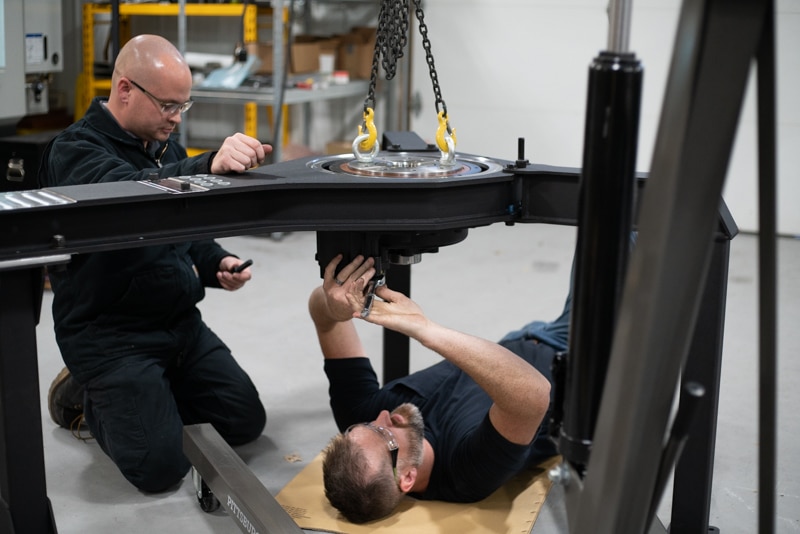
Outsourcing vs. In-House Design
When comparing outsourcing to in-house design and fabrication, several factors come into play.
In-house Design and Fabrication:
This might initially seem cost-effective, as you have full control over the process. However, the true costs are often underestimated. Apart from the direct expenses related to materials and labor, there are also significant indirect costs, including the investment in specialized equipment, software, and training. Maintaining a high level of efficiency and quality requires continuous monitoring, enhancements, and adjustments, consuming both time and resources that could be better used elsewhere.
Outsourcing to a Welding Fixture Expert:
On the other hand, outsourcing the design and fabrication of your welding fixtures to a trusted company like Kinetic Technologies offers several advantages.
1. You can leverage our expertise and experience to ensure a high-quality, efficient, and reliable fixture without the need for any in-house training or equipment.
2. The cost model is more predictable, as we assume the risk of any unexpected costs or delays.
3. Our team manages the end-to-end process, from design to installation, allowing your team to focus on your core operations.
Final Thoughts
Investing in a top-notch robotic welding fixture can yield significant dividends for your manufacturing operations. First and foremost, the direct cost savings are substantial. By reducing the need for regular replacement, maintenance, and labor costs, robotic welding fixtures produce a more cost-efficient operation in the long run.
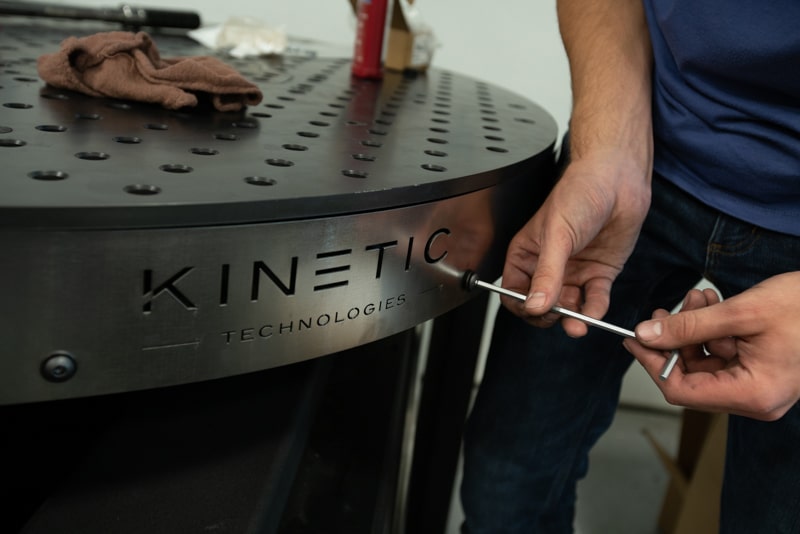
The productivity gains are equally compelling. With fixtures designed for enhanced speed and efficiency, expect increased throughput, fewer defects, and less waste.
The indirect benefits should not be overlooked either. Improved workplace safety, lower energy consumption, and a boost in your company’s reputation for quality all contribute to the return on investment.
By outsourcing your robotic welding fixture needs, you can focus on your core operations while we handle the end-to-end process from design to installation. There’s no underestimating the value a high-quality robotic welding fixture can bring to your manufacturing process.
Partner with Kinetic Technologies
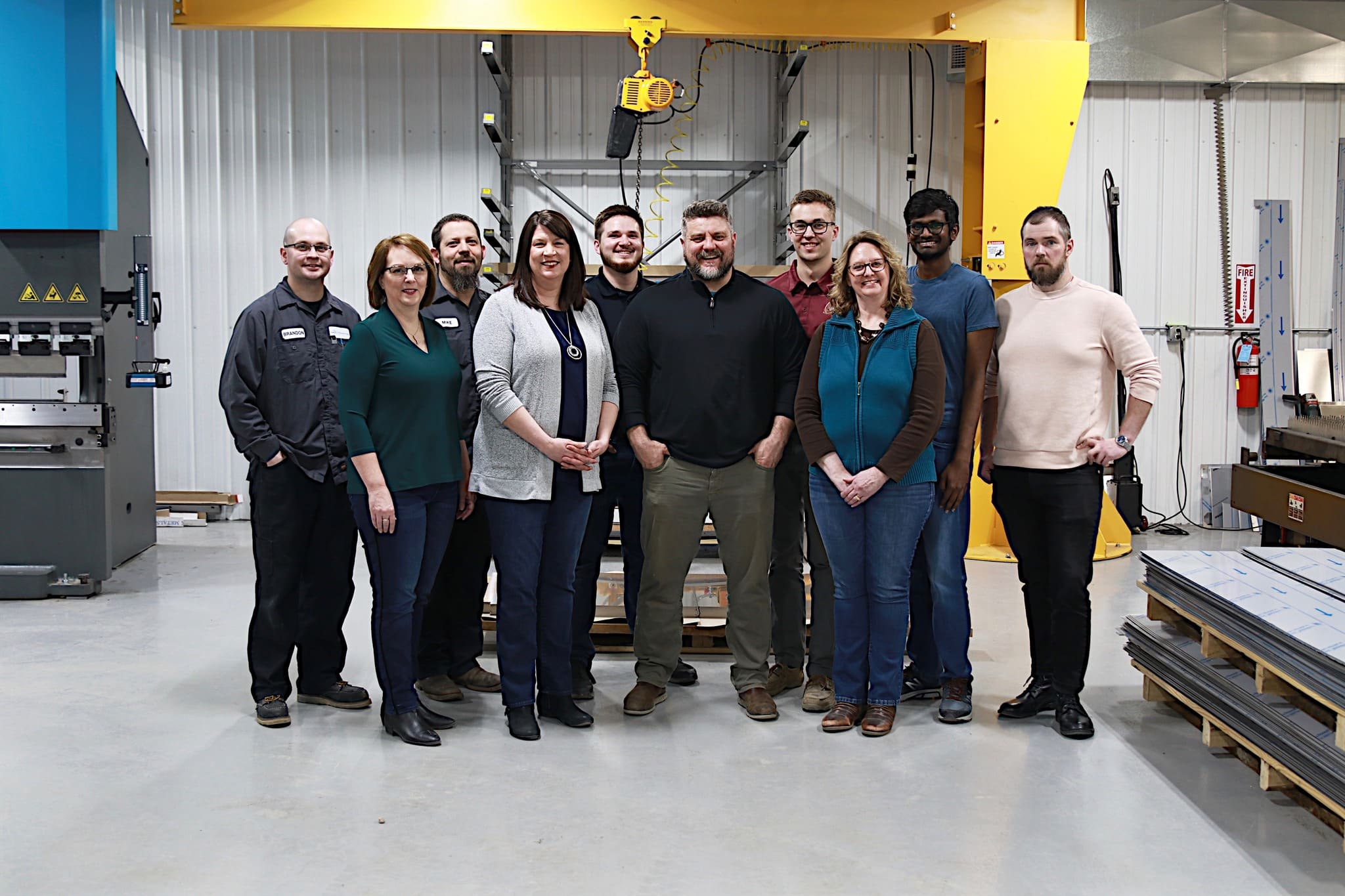
Invest in Your Future With Us
Don’t wait to reap the benefits of a top-tier robotic welding fixture. Make the strategic decision to invest in your company’s future today by partnering with Kinetic Technologies.
With our commitment to quality, efficiency, and safety, we can help you transform your manufacturing operations. Whether you’re looking to upgrade your existing fixtures or invest in your first, our team of experts is here to guide you every step of the way.
Request a consultation at Kinetic Technologies to discuss how our robotic welding fixtures can elevate your production process, boost your ROI, and secure a brighter future for your business.
FAQ
What is a positioner in welding?
A welding positioner is a device used to hold and rotate a workpiece precisely while it is welded. Positioners can be used for manual welding jobs but really shine in robotic welding applications, increasing the productivity and arc-on time of the robot.
Why do you need a positioner for welding?
Positioners are essential tools for ensuring optimal welding results. They help improve weld quality and consistency by ensuring the right welding position, allow access to difficult-to-reach areas, reduce set-up time and increase productivity for both manual and robotic welding jobs.
How do positioners improve weld quality?
Positioners can improve weld quality by providing precise positioning of the workpiece, allowing for improved access to difficult-to-reach spots. This ensures that welds are consistently placed in the correct orientation and with an even depth. Positioners also reduce the risk of repetitive motion injuries, as they can be used to hold and rotate heavy objects without manual effort.
What is the difference between a welding positioner and a welding fixture?
A welding positioner is used to precisely move and rotate a workpiece, while a welding fixture holds the workpiece in place. The fixture is installed on the positioner, which provides the necessary motion while the fixture ensures that the workpiece is held in place.
What is a small weld positioner?
Small weld positioners are ideal for handling smaller workpieces that require the same level of precision and efficiency as larger ones. They are compact, powerful, and incredibly user-friendly, making them the perfect add-on to any welding workflow that deals with small-sized projects.
What are pipe welding positioners?
Pipe welding positioners are specifically designed to hold and rotate pipes and other cylindrical workpieces. They are a type of rotary positioner dedicated to pipes. They facilitate the welding process by providing consistent rotation and stability during the weld, ensuring the welder can achieve the perfect weld seam every time.
What is a tabletop welding positioner?
A tabletop welding positioner is a device that can be used to hold and rotate small workpieces during welding. Tabletop positioners are typically smaller devices that can be installed on a working table. It provides control over the positioning of the workpiece and facilitates access to difficult-to-reach spots.
What is a rotary welding positioner?
The primary purpose of a rotary welding positioner is to facilitate the welding process by providing controlled movement of the workpiece. It allows the welder or welding robot to work at the right angle on a consistent surface.



